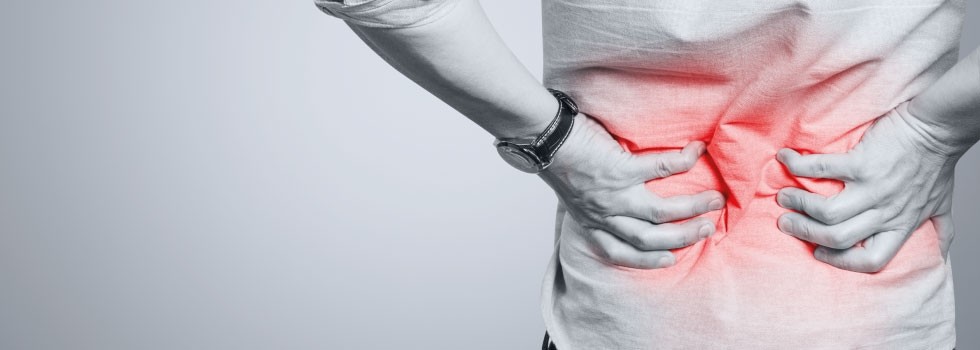Promotional Features
The use of oral CFAs in promoting the lubrication of joints
Low back pain is a widespread clinical condition, and it is estimated that about 80% of the population suffer from back pain at least once in their lives, with higher percentages among working population.1
People with physically demanding jobs, physical and mental comorbidities, smokers, and obese individuals are at greatest risk of reporting low back pain.
For almost all people with low back pain, it is not possible to identify a specific trigger, in fact it is called non-specific back pain. Only a small percentage of people have a well-known pathological cause, for example, a vertebral fracture.2
In some cases, the symptoms may be different, depending on the anatomical area affected by back pain. In general, however, the pain in the lower back is the most frequent, which often manifests itself with numbness or tingling that extends to the entire leg; it can be a symptom of inflammation of the sciatic nerve (sciatica), slipping of a vertebra or prolapse of an intervertebral disc.
Treatments
Treatment for back pain varies depending on the duration of the pain, its intensity and the needs of each person. The first-line treatments for lumbar pain management are both drug therapy for pain management, and physiotherapy. In severe cases, where the cause of back pain is anatomical-pathological (e.g. herniated disc) surgery may be necessary.
Exercise
Exercise, although difficult, would seem to reduce the time it takes to recover from low back pain. Obviously, the recommended movements to perform can consist simply of a walk.
Regular exercise day after day helps keep your back strong and healthy. Activities such as walking, swimming and practising yoga are the most common choices. The important thing is to choose a pleasant activity from which to benefit without feeling pain.
Pharmacological treatments
Generally, the most widely used drugs to alleviate lower back pain are non-steroidal anti-inflammatory drugs (NSAIDs).Despite having a significant positive result on back pain, they can cause adverse effects on the renal and gastrointestinal systems, so prolonged use is not recommended.3
In addition to common NSAIDs, classic painkillers such as paracetamol or, in severe cases, opioids such as codeine, may be used. Painkillers can cause adverse, sometimes serious effects, as they can be addictive, can interact negatively with other drugs taken simultaneously and can be contraindicated in some diseases.3
Surgery
Surgery for back pain is provided in cases where alternative treatments have not had results, or when the pain becomes so intense that it prevents you from sleeping or performing normal everyday activities. The type of surgery depends on the type of back pain and its causes.
Two of the techniques that are sometimes applied are:
- Discectomy: consists of the removal of fragments of the intervertebral discs, in order to stop the pressure they exert on the nerves (condition known as sliding of a vertebra or prolapse of an intervertebral disc);
- Spinal fusion: consists of joining two or more vertebrae with a bone graft to stabilize the spine and reduce pain.
These surgical techniques can help reduce pain caused by nerve compression, but they do not always give positive results, since complications can occur. In some cases, the nerves near the spine can be damaged and generate numbness or weakening of one leg or both legs and, in rare cases, a form of paralysis. Before undergoing surgery, it is advisable to discuss the risks and benefits of the operation with the surgeon.4
Cetylated fatty acids (CFAs)
CFAs are a mix of fatty acids of vegetable origin that have been shown to be effective in reducing muscle-joint and tendon pain, patented by Pharmanutra S.p.A. and included in Cetilar® brand products.
The mechanism of action of CFAs is to promote the lubrication of the joints and therefore to improve mechanically the movement of the joint.
The Cetilar® brand consists of three products for topical use (Cream, Patch and Tape) and one for oral administration. In fact, after eight years of research, a mixture of CFAs has been authorized as Novel Food (EU). This new ingredient, which takes the name of Lipocet®, consists mainly of a mixture of myristic acid, oleic acid and, to a lesser extent, other cetylated fatty acids.5
Lipocet® is included in the first CFA-based supplement, Cetilar® Oro, marketed by Pharmanutra SpA.
In a recent study, 27 patients with chronic back pain for more than three months were involved and supplemented with an oral administration of Lipocet® at the dosage of 1200mg daily, for four consecutive weeks.6
The results showed that both back pain-related disability and pain improved in almost all enrolled patients.
The study found that "oral CFA supplementation could be a promising solution to improve disability and pain in patients with chronic back pain as a first-line treatment".
Conclusions
Back pain is a disabling condition commonly found in the population. Regular physical activity and some daily precautions can help reduce the presentation of this painful medical condition. The use of oral CFAs has been shown to be effective and well tolerated by subjects, thanks also to their total safety and reduced adverse effects.
References
1. Freburger J.; Holmes G.; Agans R.; et al. The Rising Prevalence of Chronic Low Back Pain. Arch Intern Med. 2009;169(3): 251–258.
2. Hartvigsen J.; Hancock M.; Kongsted A, et al. What low back pain is and why we need to pay attention. The Lancet. 2018;391(10137):2356-2367.
3. Pan A.; Hai Y.; Yang J.; et al. Adjacent segment degeneration after lumbar spinal fusion compared with motion preservation procedures: a meta-analysis. Eur Spine J. 2016 May;25(5):1522-1532. doi: 10.1007/s00586-016-4415-6.
4. Backache ISSalute (August 2021).
5. EUR-Lex (2022).
6. Pelak A.; Barve A.; Carroll K.; et al. Effect of Cetylated Fatty Acid Supplementation on Axial Discogenic Low Back Pain. Int J Phys Med Rehabil. 2023; Vol.11 Iss 3 No:1000662.




